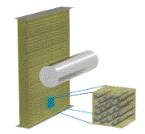Mechanical and Materials Engineering, Department of

Department of Engineering Mechanics: Dissertations, Theses, and Student Research
Date of this Version
8-2010
Document Type
Thesis
Abstract
Osteoporosis is a current disease which is especially of concern to post-menopausal women. It is characterized by a decrease of bone density and an increase in the risk of fracture. Interest in the fracture mechanisms with respect to the underlying biological structure of the bone is of great interest to researchers in this field. In this thesis, a new method based on microindentation on rat femurs was developed to determine the relation between the viscoelastic and the fracture properties of bone. The main goal is to measure the viscoelastic properties by using a dynamic mechanical analysis indentation method and then to induce a fracture by using a cube-corner indenter. As a result of these tests, the propagation of the crack can be examined with respect to the viscoelastic properties of the samples. In addition, these measurements show that the fracture is greatly affected by the heterogeneous and anisotropic nature of bone; the load applied in order to induce a fracture is different according to the sample and the crack lengths differ with direction. In the future, this method could be used on genetically modified mice which have different mineral density so that a better understanding of the fracture process can be obtained and related to biological factors affecting bone structure.


Comments
A thesis Presented to the Faculty of The Graduate College at the University of Nebraska In Partial Fulfillment of the Requirements For the Degree of Master of Science, Major: Engineering Mechanics, Under the Supervision of Professor. Joseph A. Turner. Lincoln, Nebraska: August, 2010
Copyright 2010 Séverine Vennin